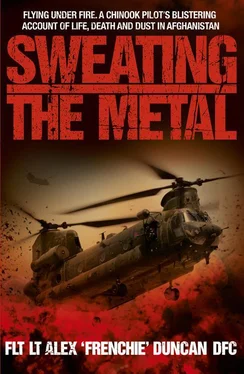Unlike commercial and private fixed-wing aircraft, where the co-pilot or student traditionally occupies the right-hand seat, it’s role-dependent in a helicopter. The right seat is generally for handling sorties, the left for navigation sorties. So to the left of my seat was the ‘handbrake’; that’s the collective and it controls altitude. Raise it and it affects all four rotor blades at the same time – ‘collectively’. It increases their pitch angle, causing the disc – and the helicopter – to rise. Lower it and the effects are reversed; the pitch angle is reduced and the helicopter descends. On some helicopters, there’s a twist-grip throttle on the end of the collective and it’s much the same as the throttle on a motorbike – twist to go faster. Things are simplified on the Squirrel, so there’s no conventional ‘twist’ throttle per se. Instead, the throttle has three more or less permanent positions: flight, ground idle and off.
So the collective controls altitude and the throttle controls rotor speed, which is known as ‘NR’. Rising vertically from the floor between the pilot’s legs is the cyclic control stick; moving it in any direction causes the disc to increase pitch on one half of its cycle while feathering on the other half. The cyclic change of pitch means that the disc tilts and moves in the same direction as the stick. Simple enough so far, right?
There’s one more major control and that’s the pedals, which work on the tail rotor. The reason that most helicopters have a tail rotor at the end of the boom is to counteract the huge forces generated by the main rotors as they move clockwise. Without the tail rotor, those forces would rotate the fuselage in the opposite direction, an effect known as torque. The tail rotor pushes the tail sideways against the torque so the amount of push – and the direction of the nose – is controlled via the foot pedals. The left one pushes the tail against the torque, so the nose moves to the left. Pushing the right one has the opposite effect.
Like I said, I knew how to fly and I knew the principles of flying a helicopter, so how difficult could it be?
John GW took us up to hover height at 5ft. ‘Okay Frenchie, see that tree at our 12 o’clock?’
‘The small one on the nose? I see it.’
‘Okay, I want you to keep us pointed at that tree. I’ll handle the rest of the controls. Got it?’
I thought about the thousands of vibrating, spinning and turning components that comprised the aircraft, each one seemingly with its own mind, powering this wild beast, this unbroken horse somehow tamed and made benign by John’s input. In his hands, the helicopter sat solidly at 5ft, rigidly pointed towards the tree about fifty yards off the nose, moving neither forwards nor backwards, neither left nor right. Minus the visual cues, we could have been motionless on the tarmac.
‘You have control,’ he said.
I pushed gently against the pedals. And for a second or so, all seemed well. Nothing changed. Then the tree was at my 10 o’clock. I pushed against the right pedal… and I watched as the tree moved past the nose to my 3 o’clock, like a roll of film scrolling across my field of vision.
‘You see the tree I’m talking about?’ John asked. I clicked the push-to-talk button on the cyclic and confirmed I did. ‘Well, if you could try to keep us pointed towards it, that would be good,’ he said, like a kindly uncle.
I focused. And gradually, the tail’s movements became less extreme. The arcs narrowed. And the tree stayed, for the most part, between our 11 o’clock and our 1 o’clock. For some of the time, I actually managed to keep it at our 12 o’clock. It was all about anticipating the response of the pedals and pressing them accordingly.
‘Much better,’ said John. When he thought I’d got control of the pedals, he gave me the collective.
‘Okay, you’ve got the collective. Look at 12 o’clock, keep the height.’ And for a while, I did. Then we started to rise and fall like we were a yo-yo controlled by some giant unseen hand.
‘Anticipate, anticipate,’ I told myself. I reduced my input on the collective – small, tiny movements. We settled.
‘Well done, Frenchie. Very good,’ he told me, giving my ego a nice boost. I could do this. And then he said, ‘Right, I’ll give you the cyclic, and I’d like you to keep us in the same position on the ground.’
I did that pretty well and I was thinking to myself, ‘This isn’t too bad.’
‘Okay. That was pretty good. Do you think you’re up to trying all of the controls at once?’ he asked. Buoyed by my success so far, I told him I’d give it a go. ‘Okay, you have control,’ John said.
‘I have control,’ I confirmed.
And I did. At least I did for a few seconds – although, as I realised later, that was mainly because he’d trimmed the aircraft for me and it flattered to deceive. Then the wind increased and I over-corrected for it. Keeping us level and static was like herding cats. If I pushed the cyclic forward, the nose went down and the aircraft descended and started to accelerate. I brought the nose up to slow down and pulled on the collective to climb and I doubled my height. When I finally managed to check the acceleration, I slowed us down so much that we were going backwards. Move the cyclic left and the aircraft slides left; right cyclic and the aircraft slides right, just like a fixed-wing aircraft, but you have to put a bit of pedal on to adjust the balance. It’s like patting your head and rubbing your stomach at the same time, while also playing keepy-uppy with a football.
‘I have control of the aircraft,’ said John, trying not to sound too nervous, although I’m sure inside he was a paragon of fear. But then, that’s the instructors’ lot. John, bless him, never seemed fazed by anything we did, and his voice – its timbre, tone, manner – never deviated. He was never flustered.
A few days later, I’d finally mastered the hover and we were out doing some ground cushion work – hovering but manoeuvring, not staying in the same position.
‘Right, when I give you control, Frenchie, I want you to look at this white line that’s at 3 o’clock. Whilst pointing the aircraft at the trees straight ahead of us, gently manoeuvre the aircraft left along the line.’
And because everything had been coming together for me, and I could hold the hover and generally control things, I thought piece of piss . Obviously, the minute I took over the controls the manoeuvre was like a dog’s breakfast. I tried, but I just couldn’t get it right.
‘I have control,’ says John. ‘I was expecting a bit better than that. We’ll try again tomorrow.’
As he flew us back to the pan at Shawbury, I felt an enormous sense of disappointment because I thought I’d cracked it. John made you want to do well. He never criticised or put you down and every comment was constructive. Even when you felt he was disappointed in you, he never said it explicitly. Always it was the soft voice, the kindly manner. It was as if your dad was teaching you something but you didn’t get it, and you’d disappointed him. He was like everyone’s dad.
Another week, though, and I’d put everything behind me. Although I was nowhere near John’s standard, he was delighted with my progress. I was holding it all together, and my basic handling was good. And I was enjoying myself. With fixed wing there are rules; but helicopters don’t obey any rules whatsoever which, I suppose, makes them quite quirky. There’s an element of me that liked that.
There wasn’t a real eureka moment for me when all the various elements of flying and controlling a helicopter came together. The way we learned means it happens slowly, so you don’t necessarily notice it. I think the first time I knew that I’d cracked it was after about fourteen hours of instruction. It was a Friday, May 17th, and it had been a routine sortie. When we landed, John said, ‘Okay Frenchie, I’m going to step out and I want you to take-off from here, go around, then come back and pick me up.’ Fourteen hours and I was left in total command of an aircraft costing one and a half million pounds. I loved it!
Читать дальше













